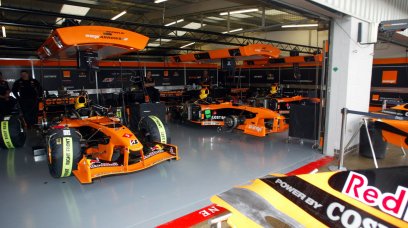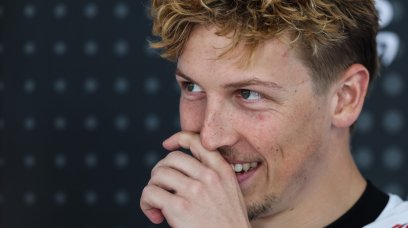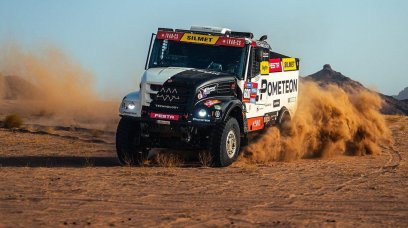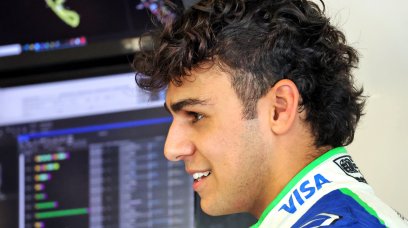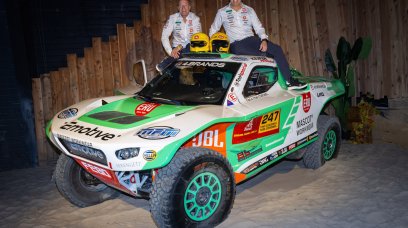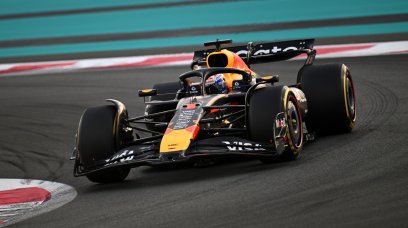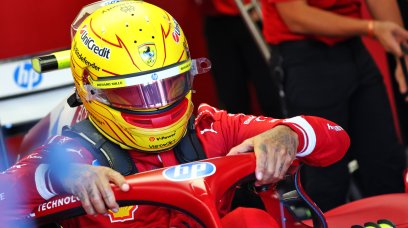Formula 1 welcomed two brand-new teams to the grid in 1997, with Jackie Stewart's eponymous outfit and respected manufacturer Lola both securing coveted spots. However, while Stewart would survive their first season in the top echelon and later thrive, Lola arrived and departed in a flash – so quickly, in fact, that they went no further than their first qualifying session at the Australian Grand Prix. On paper, Lola's project had all the key ingredients, with the hugely successful engineering company - which had previously supplied chassis to several F1 teams - combining with a major sponsor in MasterCard to make their mark on F1. Overseen by the respected Eric Broadley, Lola's founder and design chief, the plan was clear: learn as much as possible early on, deliver respectable performances and gradually work towards a championship challenge as part of a four-year cycle. But that cycle started earlier than originally intended, with Lola's target of 1998 - which included manufacturing their own V10 engine - brought forward when MasterCard joined and eagerly launched their 'F1 Club' for members, who would in turn help to fund the team through their transactions. In order to meet the new deadline, Lola rushed through their maiden car - the T97/30 - with IndyCar technology and no wind tunnel time, powered by an old Ford ECA Zetec-R 3.0 V8 engine used by backmarkers Forti in 1996.
Lola had manufactured chassis for several F1 teams, including Scuderia Italia
All the early signs were promising
Despite these design compromises, the project remained appealing, with Vincenzo Sospiri and Ricardo Rosset - who had finished first and second in F3000 as teammates in 1995 - reuniting for the challenge. Rosset already had one F1 season under his belt with Footwork Arrows, while Sospiri made the step up from a test driver role at Benetton, putting pen to paper on a four-year deal that reflected Lola's long-term ambitions. "I knew at that time for a fact that Lola had very good people, a very good engineering package and everything – they never made anything wrong," Sospiri told RacingNews365.com . "They had made good racing cars and had raced in IndyCar, and stuff like that, so it was, for me, a really good opportunity." Sospiri's thoughts were echoed by Rosset, who recalled being "very impressed" on his first visit to the Lola premises in Huntingdon, the UK. "Everything looked really promising," commented Rosset. "I remember being there in the factory and they had the prototype of the car, which was already being developed. There was also all the MasterCard sponsorship; all the marketing [team] and everything was in place. "I was very impressed, because I knew what Lola could do. We knew that it was a car to start the season and then develop through the year. "I knew we were not going to be very competitive [early on], but we didn't know how bad it would turn out to be."
Lola's dream turns into a nightmare
Lola had limited time to trial their car before the start of the season, initially heading to the Santa Pod drag strip for a shakedown, before a more traditional test at Silverstone that proved to be spectacular for all the wrong reasons. "Unfortunately for me, I went out of the pits and my car caught fire! I didn't actually drive the first day, and Ricardo did, I think, 25 laps," explained Sospiri. "On the second day, I think I did nine installation laps, out-in-out-in – I only did one run. I could feel something was not perfect. Even on a straight line, I had to fight to keep the car straight, so the aerodynamics were not working perfectly well. "I asked Ricardo, 'Ricardo, how is your car?'. He said, 'Oh, it's okay, not very fast, not much grip, but it's okay'. For me, it wasn't going straight, but it was just my car. Then when we got to Melbourne [for the first race] and it was both cars; we were fighting a little bit to keep it straight on the straight!" At the end of the first practice session in Australia, Lola - unsurprisingly - brought up the rear, with Rosset 8.6 seconds off the pace, and Sospiri 10s back. With the aforementioned handling issues not getting any better, Sospiri and his side of the garage resorted to a complete set-up overhaul between Friday's two sessions. "We changed everything! We had a debriefing and they said, 'Look, we understand nothing is working here, so we need to try to use this race weekend to understand and get some data for when we come back'," Sospiri recalled. "It was basically the full car, before qualifying. I said, 'Why not? We have nothing to lose, we're last anyway'. Ricardo didn't want to do it, so I told [the team] they could decide and in the end they did it, [with] everything completely new."
Sospiri in action during the 1997 Australian Grand Prix weekend at Albert Park
From one extreme solution to another
Adding to Lola's post-practice workload was a faulty gearbox that left Rosset and Sospiri struggling to maintain any sort of momentum around the lap. "It was really bad! I mean, the gearbox didn't work at all," said Rosset. "I couldn't really get an idea of how capable the car was, because it wouldn't change gear. [I was stuck] in fourth gear, fifth gear, so we couldn't even take the car to the limit – it was not running properly." The situation was so bad that Rosset revealed a bold plan - albeit one that was quickly scrapped - to replace Lola's semi-automatic gearbox. "I remember during practice, they thought about changing the gearbox to a manual gearbox," he said of the team's reaction. "It was not possible, [with the] space and everything, [having] to go through the hydraulics to the engine. I don't know if it was a software problem, but both cars didn't work. Sometimes they would change gear, sometimes we would be stuck in gear. "We were sometimes very far apart from each other, and from the [rest of the] grid, because one car would change gear and the other wouldn't change gear." Despite their best efforts to rectify the handling and gearbox issues, Lola would become a victim of the 107 per cent rule with both cars on qualifying day – 8 March, 1997. Sospiri ended up 5.347s away from the cut-off, with Rosset just over a second further back – the situation made slightly worse by Jacques Villeneuve's storming pole position lap.
Going bankrupt in Brazil
At the next round in Brazil, what should have been a celebration for Rosset on home soil was anything but. He discovered that MasterCard had backed out - and the team had pulled the plug - on his arrival at Interlagos. "I got the news when I went [to the track] on Thursday," said Rosset. "When the team arrived I went to see them and the [garage] door was closed. I didn't understand what was happening and then they told me the news. "I had some sponsors that already had some money in the team. We tried to get the money back, but never got the money back. "It was really hard for me to explain to the press here in Brazil what was happening because I didn't know what was happening." The same went for Sospiri, who found out what was going on by reading a newspaper, before promptly calling his teammate and asking him for a favour. He said: "I was ready to go to the circuit. I came downstairs for my breakfast with my dad and some other friend, and one guy [with a] newspaper said, 'Lola has closed down; Lola is bankrupt'. [I said], 'What are we doing? Are we going to the circuit, or not?' "I picked up the phone, I called Ricardo, and I said, 'Ricky? Where are you? Is it true?' [He said], 'Yes it's true. They're locking everything down because it is bankrupt, they're taking everything away'. "I then said, 'Can you please take my bag with my helmet and my suit before they take it away?' So he took it out for me from the garage before they locked it up!"
707617963847786496
Remember this? Name the team. Hint: their only #F1 appearance came in qualifying #OnThisDay in 1997... pic.twitter.com/azYPUPHZT7 — Formula 1 (@F1) March 9, 2016
Sospiri and Rosset live to fight another day
And with that, the Lola journey was over before it had even started with the F1 record books reading one failed qualifying attempt for both cars. While Rosset secured a return with Tyrrell in 1998, another F1 opportunity would not come Sospiri's way, and he was left to rue what might have been if Benetton team boss Flavio Briatore had given him a shot. "I don't think I had my chance in Formula 1; I think I deserved a little bit more," said Sospiri, who was later named by seven-time World Champion Michael Schumacher as one of his racing heroes – the Italian having enjoyed a prolific karting career. "I think Briatore, who everybody says is somebody who knows the drivers, didn't understand very well my potential, even though probably [Technical Director] Ross Brawn and other engineers told him that I was quick – but he didn't care." Sospiri, who headed for the United States and IndyCar after the F1 door closed on him, now runs a successful GT racing team of his own in Europe, while Rosset exited the sport at the end of 1998 and turned to business with the Brazilian sportswear brand Track & Field. As for team boss Broadley, he was left trying to save the name of a company he had worked so hard to build up. Just before the millennium, he sold the company to Irish businessman and former racing driver Martin Birrane, and the journey was over. Broadley passed away in 2017, some 20 years on from the failed Lola effort, but Sospiri stressed that the team's founder should be remembered for his array of design accomplishments across F1, IndyCar and sportscars. "Unfortunately for Broadley, [the Lola F1 project] didn't work out and it destroyed his career as a manufacturer," he commented. "It was really sad because I really liked the guy. I know he is not here anymore, but he was a great person and a fantastic engineer."
Most read
